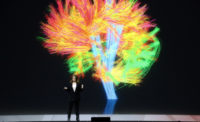For those of us who live in the shadow of an empty sky, there is a particular duplication of mourning, for what was once and is now gone, but also for what is to come.
I started thinking about what should be done about the World Trade Center right away. The only difference between the professionals and me is that my ideas have absolutely zero chance of being realized and I am afraid my worst fears will be.
My first desire was that I wanted the towers rebuilt exactly as they were. That is a child's cry: in the years after my father died (when I was 11) if I got upset about something that didn't go my way, I would wail, "I want everything to be the way it was before". But of course that can't be. I feel certain that the memorials that will eventually be built will replicate aspects of war memorials on the Mall in Washington, both what is there and what is planned for the WWII memorial. The victims' relatives will insist on one of those safely tasteful memorials, the firefighters will want World War II style realist heroic statuary, and business leaders will want cost effective Starbucks architecture. So there will be representational statuary of heroic firemen and there will be an elegantly bland something emulating Maya Lin’s wall. The radicality of that work persists but to copy its minimalist aesthetic now is to kill its radical performativity.
I can't stand the idea of some safe boring public art memorial, like the one in Oklahoma City. I haven't seen it in person, maybe it is beautiful when you are there but I thought they should have gotten Jeff Koons to do that memorial since his work picks up the same layer of American kitsch as the impromptu wall with flowers, teddy bears, children's cards, and votive candles that are the truest American popular form of monuments for mourning. I walked down to the Battery Park City side of the site and saw one of the last shrines, a hedge of teddy bears, with handwritten messages to lost sons, mothers, and brothers. People were sobbing, and one woman picked up teddy bears at the top of the pile, smoothed them out a bit and carefully put them back. The bears have that comforting, fluffy and immutable presence. A mountain of teddy bears and notes and pictures of the dead, that would be a good memorial.
Or, they should have left one of the façade ruins up, those tremendously authentic fragments, great incarnations of the grid undone. But all the traces are down and any reinstallation of such fragmentary relics would only be a simulacrum, so like the teddy bears, and even the improvisatory circle fashioned for the first anniversary commemorative events, it has been eliminated as an integral, memorial. It would take too great a leap of imagination and self-awareness to seize on such temporary yet organic visual events. And perhaps it is for the good that the site had to been cleaned completely, surgically scoured like a root canal in order to allow the new to occur. Yet I dream the following on the night of May 17/18, 2002: "I go down to Century 21. On my way out I find that I am able to get up on a very small rise in the pavement at the North East corner of the site, right at the edge of the pit. It is completely empty and swept clean. I start to cry. The city skyline to the North looks like a painted backdrop very far away."
In the past few months I have been taking random pictures of the Empire State Building and the Chrysler Building, in the spirit of, "I can see them from here," or, in order to be prepared in the case of further disaster, "I could once see them from here." Inevitably, given the limitations of my camera and my skills as a photographer, the buildings are barely visible and far away, just as in my dream of the "city" seen from the "site." But having taken the World Trade Center for granted, I now want to fix my own daily experiences of living in a city with these buildings. The fact that these buildings have been exhaustively and excellently documented is not relevant to my personal need to secure my own memory. "I can see them from here" feels necessary because for my lifelong residence as a New Yorker and my 23 years living in Lower Manhattan, I have only one picture I took of the Towers, an utterly generic view of the downtown skyline as seen from the Staten Island Ferry on a fine day in May 2000. In this picture they seem almost like a mirage, a brighter version of the distant skyline in my dream.
It took me a long time to figure out that one of the things that made Tribeca feel wrong was the light — there is too much of it now that the Towers no longer cast what evidently was a lengthy shadow. Every day this increased brightness casts its own emotional shadow as we move about the streets. Planes fly low, directly over and across the neighborhood now that they can, in a mockery of our sensibilities. Something must be reinstated that will lift our spirits, give us something to look at, make planes on their ordinary trajectories have to avoid that spot of sky. The Towers of Light, even if they were in the wrong place, even if they were dim, cheered up the neighborhood while they lasted. We need to have something to look at in the sky, other than the sky.
If the towers can't be rebuilt as was then I want something else to look at, something as spectacularly tall, to see from afar. Something even better than the towers, something exhilarating that affirms human aspiration. My first response was that there should be an international competition and Frank Ghery shouldn't be allowed to apply, but of course that is because I immediately imagine one of his swooping wall designs adapted to a tower, like falling pages of silver leaf. Early on, Paul Goldberger suggested that a very tall tower be built, but that most of it be empty, purely decorative, so that no one would live or work in it. I like that idea. A Tour Eiffel but taller and more spectacular, lit up in the night and catching the daylight the way the Towers did.
My dream image of the broom clean pit is the reason that I originally felt sympathetic to the original plans presented by Daniel Libeskind. The concept of the bathtub visible down to bedrock was resonant to my sense of loss. But in the last days before the official decision was made to chose the Libeskind design, I changed my mind: the architecture itself seemed mannered and boring, and I decided that the two empty scaffold like structures proposed by the Think team would be something that would look forward and upward, impractical but gleefully wild in a manner that would be embraced by New Yorkers for decades after the memory of the World Trade Center towers would have faded, rather than an elegiac look backwards, downwards as in my dream.
They would be the new Eiffel Towers. No such luck. Now the forces that really determine what happens in New York real estate have already whittled away first at the depth and scale of the visible bathtub wall in the Libeskind design, finally at the concept itself. Thus the only real reason to chose that plan has already been compromised -- and I have come to feel that the reason that Libeskind was chosen was precisely because his desire to get the project was so great that it signaled to the powers that be that he would compromise. He could be had. And the chance for something that would perhaps be as truly wonderful as the World Trade Center has become in our memory is to be denied so that loss remains total.
* * *
One final imagined image: that at the very center of where the old complex had been would be a small replica of the towers made of precious metals and jewels, a Fabergé egg of the World Trade Center, as it were.















Post a comment to this article
Report Abusive Comment